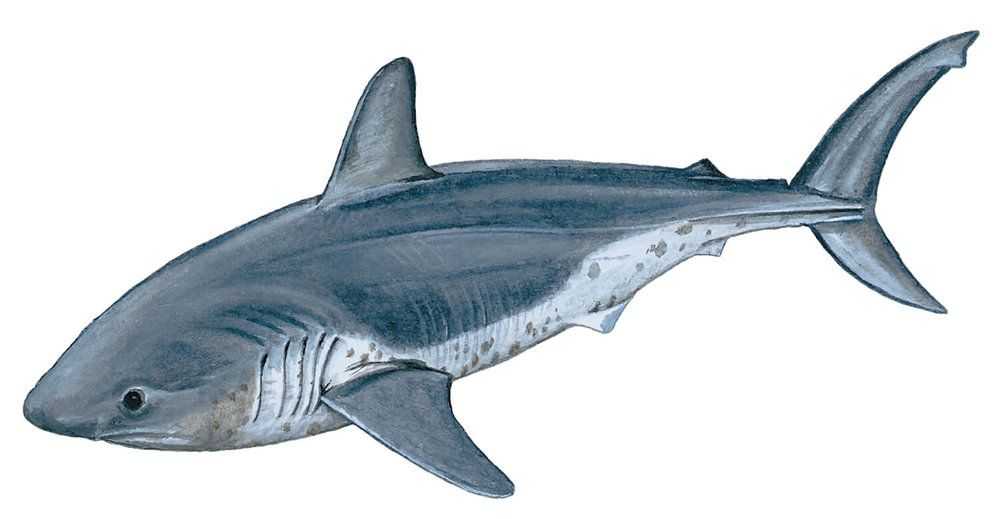Salmon Shark

Species Details
Lamna Ditropis
Lamnidae
Lamniformes
Nearshore, Offshore
210 - 1000 lbs.
72" - 120"
What Is a Salmon Shark's Size?
A salmon shark's (Lamna ditropis) average size is 6 feet (183 cm) long and 210 pounds (95 kilograms) in weight. The biggest of this saltwater species can grow up to 12 feet (366 cm) - the maximum length recorded - and weigh up to an astounding 1000 pounds (453 kilograms).
The Salmon Shark (Lamna ditropis) Description
The Salmon Shark is a saltwater fish that belongs to the mackerel shark species, making it closely related to the famous great white shark and the mako shark. It is dark-grey in color, with a white underside belly, and dark blotches at the top. Its snout is short, blunt, and conical in shape. Its gills are quite large for their size. It’s also one of the only two species of sharks that has a double keel.
This large fish prefers colder temperatures and is mostly found in pelagic waters, but they can also be found in epipelagic, offshore, and coastal areas.
The salmon shark is an apex predator that has a voracious appetite. It eats 8% of its body weight a day. It mainly feeds on salmon, squid, sablefish, and herring.
Interesting Facts
- This fish can maintain its internal temperature, which is normally only found in warm-blooded animals. They do this so they can thrive in the cold waters where they live.
- The fish is generally considered pests for fishermen since they often steal from the catch and because they can damage their equipment when they get accidentally hauled in.
- In Japan and Alaska, the fish is considered a delicacy. They say it tastes like swordfish. The shark can also be used as leather, oil, and the heart for sashimi.
Size and Speed
The Salmon Shark has an average size of 6 feet and 210 pounds. The maximum length recorded of this fish is 12 feet, while the maximum weight is an astounding 1000 lbs.
The max speed of the salmon shark is an incredible 50mph, making it one of the biggest and fastest fish in the world. They need this remarkable speed to capture their fast-moving prey like the salmon.
Habitat & Distribution
The salmon shark is mostly found in the North Pacific Ocean’s subarctic and temperate waters. They prefer temperatures of 36.5°F to 75.2°F and they live on continental offshores in depths of at least 500 feet.
They migrate to vast areas of the North Pacific. Their range stretch from the Bering Sea to the Sea of Japan in the western Pacific, and from the Gulf of Alaska to southern Baja California, Mexico, in the eastern Pacific. They’re available throughout the year but are most common in July and August.
Salmon sharks from the northeast Pacific follow a similar north-south migration in California, Oregon, Washington, Alaska, and Canada. In spring, they go south to give birth in Oregon and California. They mate in the summer or autumn.
Anglers looking for this fish visit Prince William Sound in Alaska for this up-and-coming game fish. They’re mostly solitary but they can congregate in large numbers to hunt their prey.
Fishing Techniques - How to Catch Salmon Shark
Anglers love the aggressive nature of the salmon sharks. They put up a good challenge for the fishermen and the fish is just a sight to behold. They’re known for their endurance and battles usually last about 30-40 minutes (sometimes it takes up to 2 hours). Because of its size and strength, it’s extremely hard to fish it alone; group effort is a must to haul this fish.
A boat is needed for this game fish as they don’t come near the shore. The equipment recommended is a spinner rod with a weight of 12-14, with an 80-pound line equipped with a 6-foot wire leader.
It’s rare to fly fish salmon sharks, but there have been successful anglers who tested the limits of fly fishing. Some used a 15 weight rod and a 14 weight reel, customized with heavy flies. Both spinner rods and fly rods were advised to equip 12 or 13 sized circle hooks.
First, use chum to attract the sharks, then use a salmon fillet bait with a silver-metallic lure that mimics their prey. Move the lure around to get their attention and wait for them to take the bait.







